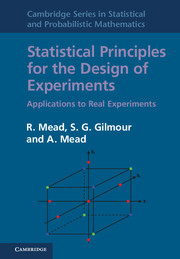Book contents
10 - Randomisation
from Part II - First subject
Published online by Cambridge University Press: 05 November 2012
Summary
What is the population?
The fundamental results on which most inferences for data from experiments are based were described and proved in Chapter 4. All these results are based on the assumption that the experimental units are a sample from a normally distributed population. This assumption is made for many other sampling situations, and is frequently accepted as being a reasonable approximation. Transformations of the observed variable may be necessary to ensure that the assumptions of normality and homogeneity of variance are satisfied. However, for most analyses of sample data from observational studies, it is possible to envisage a population of which the sample may be realistically accepted as representative. In designed experiments, the very careful control which is exercised often makes it difficult to identify a population for which the sample is relevant.
In field crop experiments, small plots are marked out and treated with great care so that the plots may be regarded as homogeneous, and the treatments may be compared as precisely as possible. In some animal nutrition experiments, animals are surgically treated so that more detailed observations can be made. In psychological experiments, subjects are subjected to stresses in controlled situations, and are required to complete specified tasks, often in very limited times. In industrial experiments, machinery is operated under each set of conditions for a short period of time. Often the machinery will be of the same general type as, but not identical to, those used in production.
Information
- Type
- Chapter
- Information
- Statistical Principles for the Design of ExperimentsApplications to Real Experiments, pp. 233 - 255Publisher: Cambridge University PressPrint publication year: 2012
